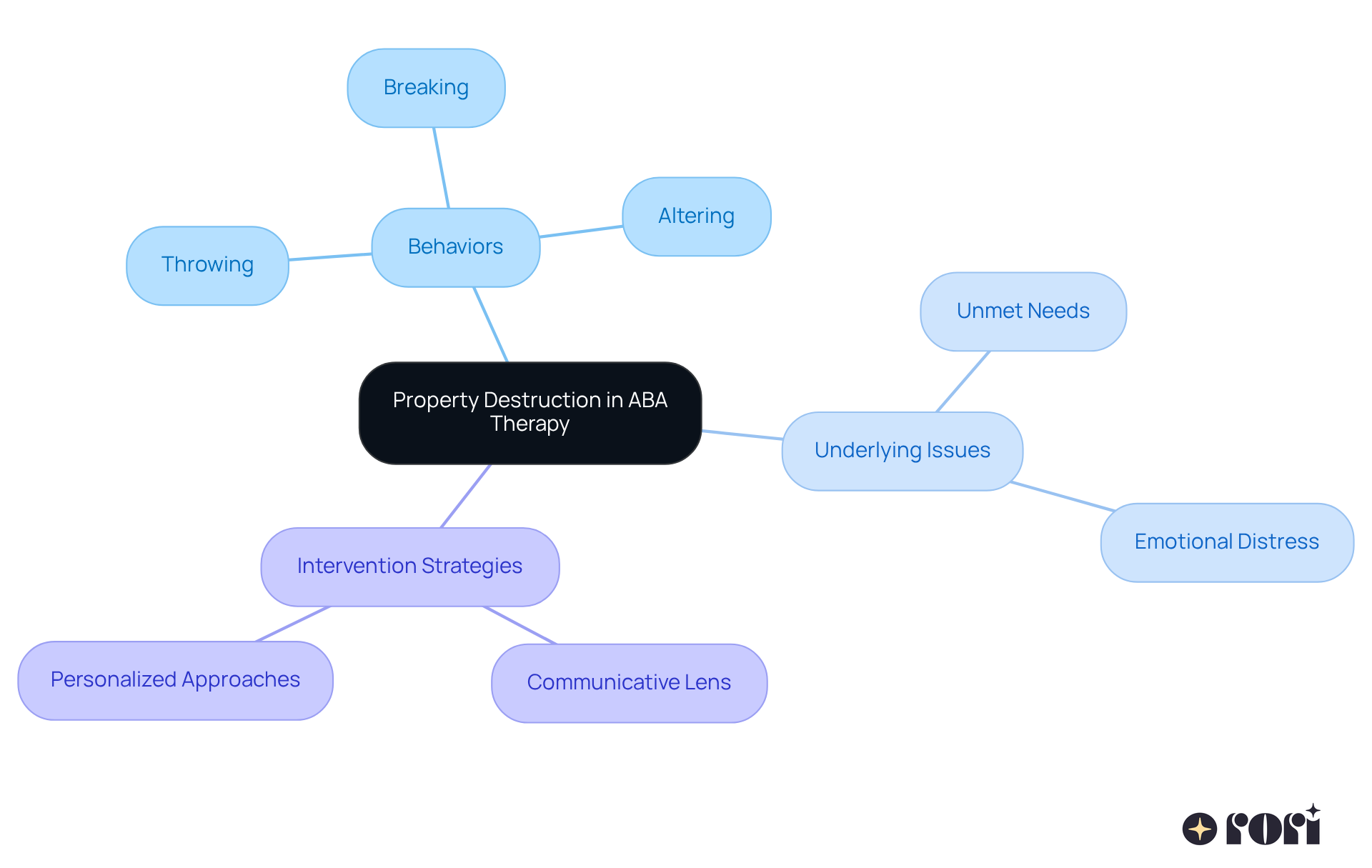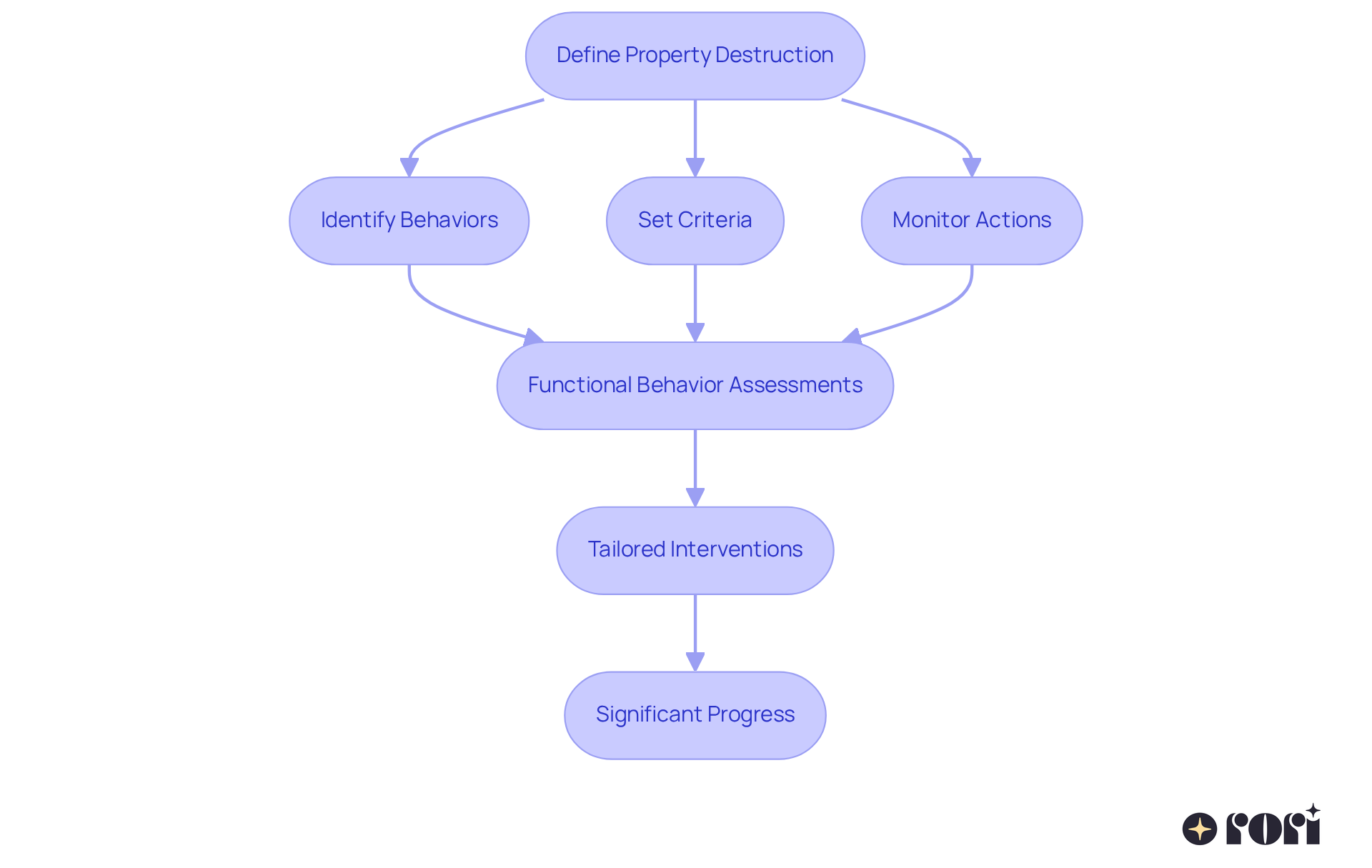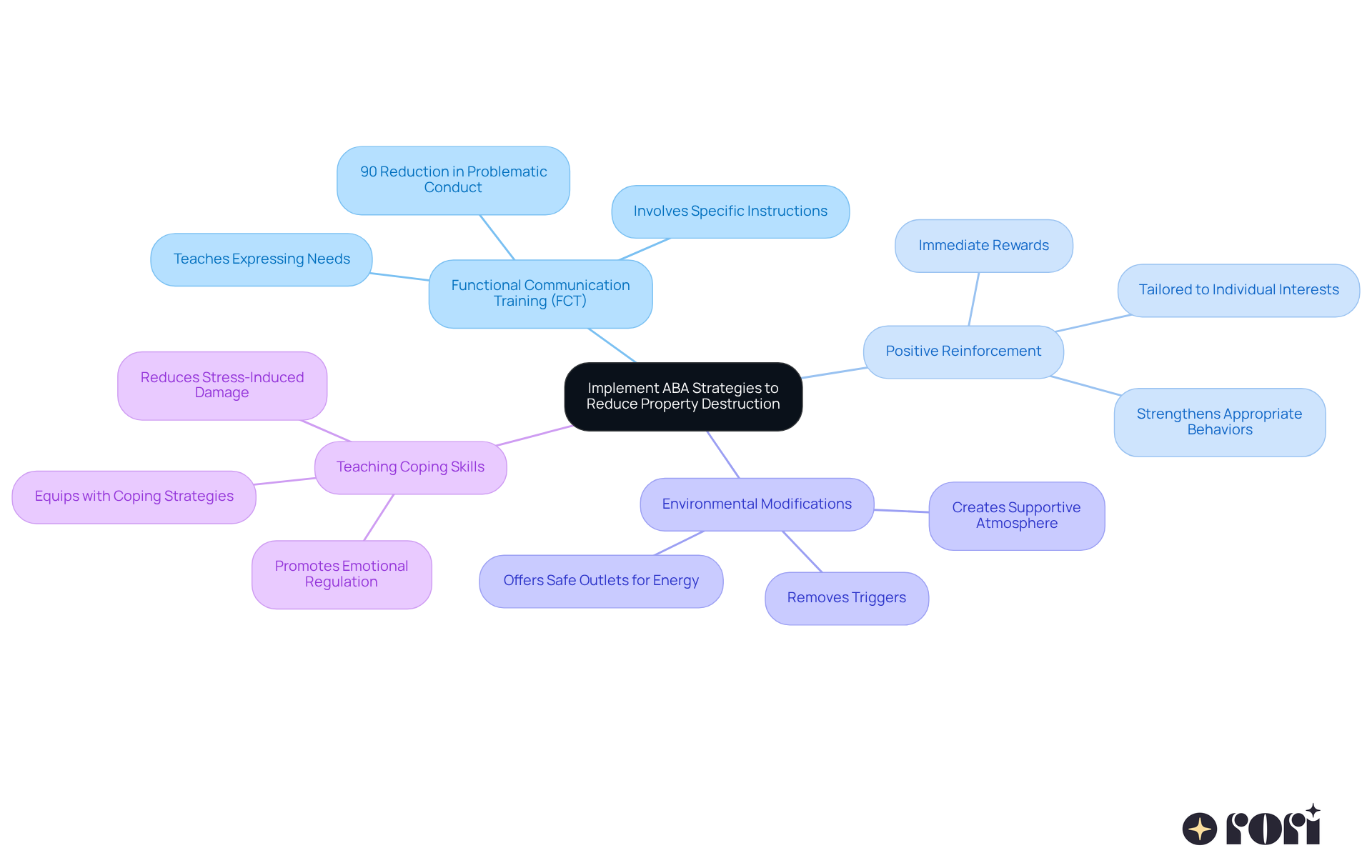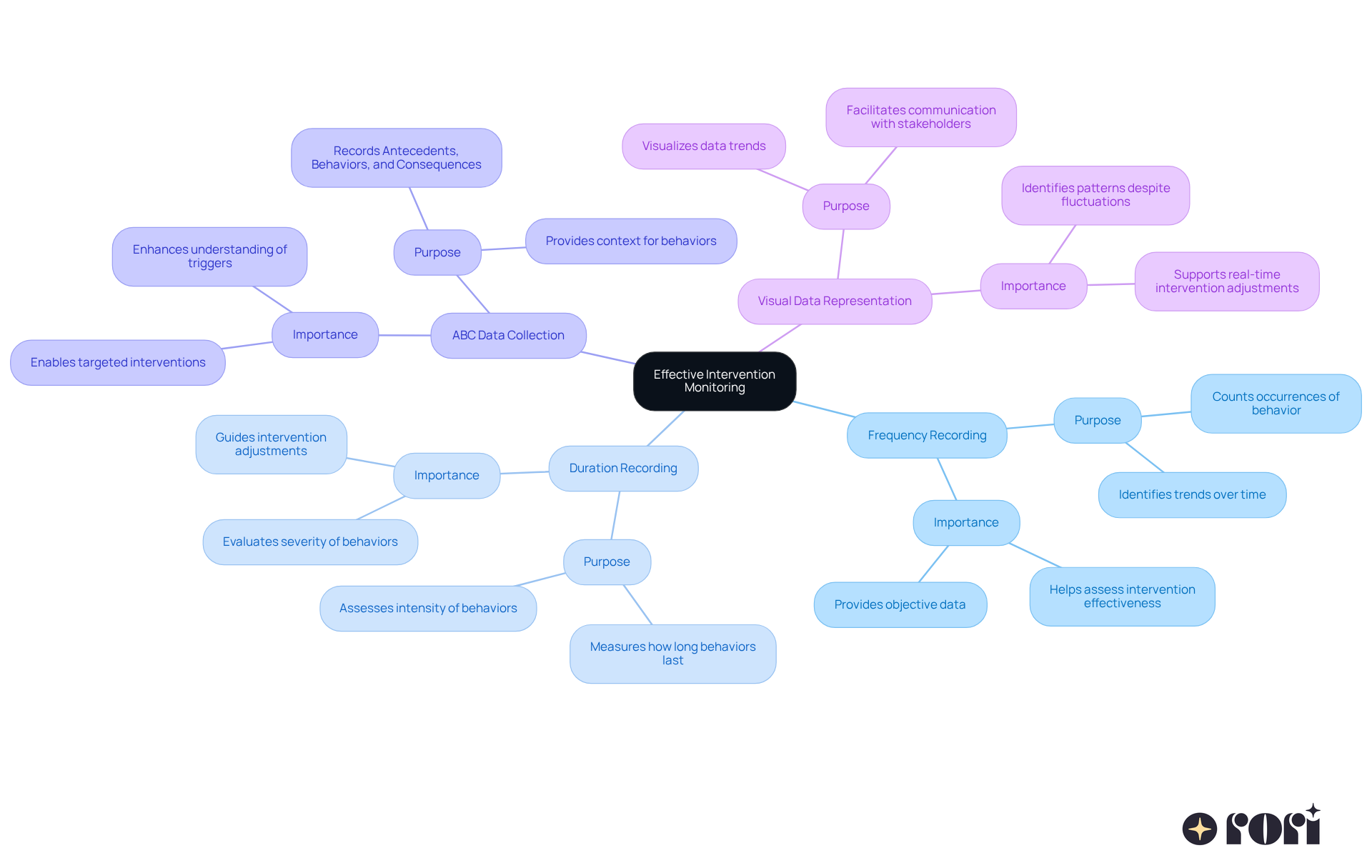This article dives into the concept of property destruction within the realm of Applied Behavior Analysis (ABA) therapy. It’s important to understand that these behaviors often signal unmet needs or emotional distress in children. By defining these behaviors clearly and using tailored ABA strategies, caregivers can make a real difference in reducing such actions and better supporting the emotional and developmental needs of their little ones.
Let’s think about it: when a child destroys property, it might be their way of expressing something they can’t quite put into words. This is where ABA can step in! With the right strategies, caregivers can address these behaviors effectively. It’s all about understanding the root causes and responding in a way that nurtures the child’s needs.
By focusing on these tailored approaches, we can create a more supportive environment for our children. Remember, you’re not alone in this journey! Let’s explore this together and find the best ways to support our children’s emotional well-being.
Understanding the nuances of property destruction within the framework of Applied Behavior Analysis (ABA) therapy is essential for effective intervention. This behavior often signals unmet needs or emotional distress, and it can significantly impact therapeutic outcomes for children, especially those with autism.
By exploring operational definitions and tailored strategies, caregivers and clinicians can not only mitigate these damaging actions but also foster healthier emotional and developmental growth. What if we viewed a child's destructive behaviors as vital communication tools?
Let’s explore this together!
When we consider these behaviors as a form of communication, it opens up a whole new perspective on how to support our children. By understanding the underlying reasons for these actions, we can better address their needs and help them thrive.
In Applied Behavior Analysis (ABA) therapy, the property destruction operational definition aba encompasses any action a child takes that harms items, materials, or surfaces around them. This can include throwing, breaking, or altering things—whether they mean to or not. Recognizing the property destruction operational definition aba is crucial for developing effective intervention strategies. Often, these actions communicate unmet needs or emotional distress.
Did you know that around 59% of individuals with autism engage in self-injurious or harmful behaviors at some point in their lives? This highlights how common such actions can be in this community. Analysts point out that understanding these behaviors can lead to more personalized interventions. As one specialist wisely noted, 'Challenging actions do not happen in isolation.' This means they often reflect deeper issues that need our attention.
By viewing damage to belongings through a communicative lens, caregivers and clinicians can implement strategies based on the property destruction operational definition aba that not only help reduce these behaviors but also support the young person's overall emotional and developmental needs. Let’s explore this together!

To effectively tackle property damage, it’s important to establish the property destruction operational definition aba. According to the property destruction operational definition aba, property damage can occur in any instance where a child throws an object with force, kicks furniture, or intentionally breaks items. These definitions should include specific criteria, such as the context of the behavior and the intensity of the action, based on the property destruction operational definition aba. For instance, tossing something from at least six inches away or upending furniture are clear examples of damaging belongings.
This clarity helps in consistently monitoring actions and assists in planning interventions. It ensures that everyone on the team, including Board Certified Behavior Analysts (BCBAs), is on the same page. One BCBA shared that having clear expectations can really boost students' motivation to work towards their rewards. Plus, it’s fascinating to note that property damage actions can be reduced by an average of 96% when ABA interventions are tailored to individual needs, supported by ongoing progress reports and active caregiver involvement.
When we achieve full implementation of the recommended hours, we see significant progress in 90% of children. Functional Behavior Assessments (FBAs) are also vital in pinpointing triggers for these behaviors, allowing for more effective intervention strategies. By focusing on visible and measurable actions, practitioners can minimize damage and promote positive outcomes. Ultimately, this approach can enhance the effectiveness of ABA therapy, especially with the help of AI-driven progress report automation. Let’s explore this together!

To effectively reduce property destruction, several Applied Behavior Analysis (ABA) strategies can be implemented:
Functional Communication Training (FCT): This method teaches children to express their needs or frustrations through spoken communication or other means, which helps decrease reliance on harmful actions. Research shows that FCT can lead to significant reductions in challenging behaviors, with studies demonstrating a 90% decrease in problematic conduct when implemented effectively.
Positive Reinforcement: Strengthening appropriate behaviors is key! By providing incentives when a young person engages in non-destructive activities or communicates effectively, the likelihood of these positive actions occurring again increases. Tailoring reinforcement techniques to fit the individual’s interests makes them even more effective, as immediate rewards after preferred behaviors can greatly boost engagement.
Environmental Modifications: Sometimes, changing the environment can help reduce triggers for damaging behavior. This might mean removing breakable items or offering safe outlets for energy, creating a more supportive atmosphere that discourages destructive actions.
Teaching Coping Skills: Equipping young individuals with coping strategies to manage frustration or anxiety is essential. By teaching these skills, the chances of resorting to damaging belongings in response to stressors are lessened, promoting healthier emotional regulation.
These strategies not only address the property destruction operational definition aba but also nurture overall behavioral development, enhancing communication and social skills in children with autism. Let’s explore this together!

Effective intervention monitoring in ABA therapy is all about systematic data collection, and it’s even better with adaptive treatment plans that evolve based on progress report data and active caregiver involvement. Let’s take a look at some key methods to implement:
Frequency Recording: This method involves keeping an eye on how often damage to assets occurs within a specific timeframe. By spotting trends and triggers, therapists can gain a better understanding of the situations that lead to these actions. Research shows that ABA therapy shines when progress is consistently tracked through data collection, reinforcing just how vital this method is.
Duration Recording: By assessing how long damage-causing actions last, we can glean insights into the intensity and impact of these activities. This information is crucial for evaluating the severity of the behavior and tailoring interventions accordingly.
ABC Data Collection: Recording the Antecedents, Behaviors, and Consequences surrounding instances of the property destruction operational definition aba helps therapists grasp the context and purpose behind the actions. This comprehensive approach allows for more targeted interventions that really make a difference.
Visual Data Representation: Using graphs or charts to visualize data trends over time makes it easier to share progress with families and other professionals. Visual tools like graphs help identify patterns in data, even when there are fluctuations. By consistently reviewing this data, therapists can quickly adjust intervention strategies, ensuring they remain effective and adaptable to the individual’s changing needs.
The power of frequency recording in behavior analysis lies in its ability to provide objective, quantifiable insights into a young individual’s actions. Behavior analysts emphasize that ongoing data monitoring is essential for making informed decisions about intervention approaches, ultimately leading to better outcomes for young individuals. Plus, low variability in data fosters greater agreement among experts and BCBAs on intervention effectiveness. By integrating these data collection methods, along with AI-driven progress report automation, therapists can create a more personalized and effective approach to managing behaviors under the property destruction operational definition aba, freeing up 50% more time for child treatment.
Let’s explore this together! We're here to help you every step of the way!

Understanding property destruction in the context of ABA therapy is crucial for creating effective interventions that tackle the root causes of these behaviors. When we see actions like throwing or breaking items, it often points to unmet needs or emotional distress. By approaching these situations with empathy and thoughtful strategies, caregivers and clinicians can make a real difference. This perspective not only helps reduce property damage but also supports the emotional and developmental growth of the individual.
Key insights from the article emphasize the need for:
Techniques like Functional Communication Training, positive reinforcement, environmental adjustments, and teaching coping skills can help minimize destructive behaviors while encouraging healthier communication and emotional regulation. Plus, collecting data systematically offers a deeper understanding of these behaviors, allowing practitioners to adjust their interventions based on real-time insights.
Addressing property destruction in ABA therapy is about more than just preventing damage; it's about nurturing the well-being and growth of individuals with autism. By implementing tailored interventions and actively involving caregivers, we can significantly enhance the potential for positive outcomes. Embracing this comprehensive approach can lead to transformative changes, ultimately improving the quality of life for those affected.
Let’s explore this together! Remember, we’re here to help you every step of the way!
What is the definition of property destruction in ABA therapy?
In Applied Behavior Analysis (ABA) therapy, property destruction refers to any action a child takes that harms items, materials, or surfaces around them, including throwing, breaking, or altering things, regardless of intent.
Why is it important to recognize the property destruction operational definition in ABA therapy?
Recognizing the property destruction operational definition is crucial for developing effective intervention strategies, as these actions often communicate unmet needs or emotional distress.
How common are self-injurious or harmful behaviors among individuals with autism?
Approximately 59% of individuals with autism engage in self-injurious or harmful behaviors at some point in their lives, indicating that such actions are quite common within this community.
What do analysts suggest about understanding property destruction behaviors?
Analysts suggest that understanding property destruction behaviors can lead to more personalized interventions, as these challenging actions often reflect deeper issues that require attention.
How can caregivers and clinicians approach property destruction behaviors?
By viewing property destruction through a communicative lens, caregivers and clinicians can implement strategies that not only help reduce these behaviors but also support the young person's overall emotional and developmental needs.